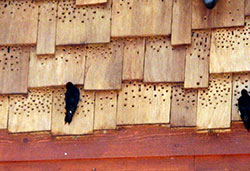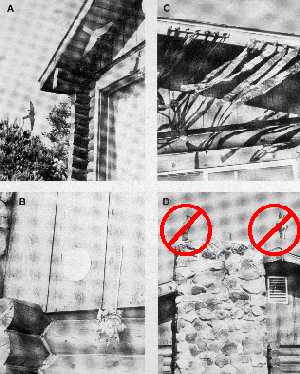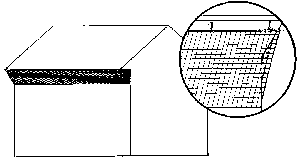by W.F. Andelt, S.N. Hopper and M. Cerato* (8/14)
Revised by M. Reynolds**
Quick Facts…
- The northern flicker, responsible for most woodpecker damage to Colorado homes, is identified in flight by a yellow or salmon tint under the wings and tail feathers.
- Woodpeckers cause property damage by drilling holes in wood and synthetic stucco siding and eaves, and are an annoyance when hammering or “drumming” on houses.
- Control damage by preventive construction, scare devices and exclusion.

Woodpeckers are 7 to 15 inches long, have short legs, sharp-clawed toes and stiff tails. Most woodpeckers feed on wood-boring insects, insects on trees and the ground, vegetable matter, berries, or tree sap.
The northern flicker (Colaptes auratus), responsible for the most woodpecker damage to Colorado homes, is identified in flight by a yellow or salmon tint under the wings and tail feathers. Flickers have black spots on a tannish-white breast and belly. Males have a black or red mustache extending from the gape of the beak to below the eyes. The red-headed woodpecker (Melanerpes erythrocephalus), red-naped sapsucker (Sphyrapicus nuchalis), Williamson’s sapsucker (Sphyrapicus thyroideus), hairy woodpecker (Picoides villosus), and downy woodpecker (Picoides pubescens), also occasionally cause problems in Colorado.
Damage Identification
Woodpeckers cause property damage by drilling holes in wood and synthetic stucco siding and eaves, and are an annoyance when hammering or “drumming” on houses. Woodpeckers hammer to attract mates, to establish and/or defend a territory, to excavate nesting or roosting sites, and to search for insects. Wooden, cedar or redwood siding, metal or plastic gutters, television antennas, chimney caps, and light posts are selected as drumming sites because these materials produce loud. Drumming is most common in the spring during early morning and late afternoon and usually ends by July 1.
Control Methods
Woodpecker damage can be prevented or eliminated with several techniques including visual repellents, loud noises, exclusion, alternate construction materials, providing nesting boxes, and as a last resort, killing. Take immediate action to reduce damage because woodpeckers are not easily driven from their territories or pecking sites once they are established. Nests may be removed as long as there are no eggs or young in the nest. Once eggs or young are in a nest they must be left alone until the young have fledged and flown away.
Visual Repellents
Preliminary research indicates that 7-1/2 inch diameter shaving or cosmetic mirrors that enlarge the image and hawk silhouette mobiles are successful frightening devices.
Mirrors should be placed on the side of the house where damage occurs (see Figure 1B). Attach one or two mirrors flat to the wood with the enlarging lens outward to frighten woodpeckers. Mirrors may be purchased at drug or department stores.
Hawk mobiles with a wing span of about 22 inches and a length of 11 inches, can be constructed from cardboard, 1/2 inch Styrofoam, or 1/4 inch plywood (see Figure 1A). Paint black or another dark color. Hang one hawk mobile from the eave near the damaged area with monofilament line.
 Figure 1: Hawk mobiles (A), 7-1/2-inch-diameter shaving mirrors (B), and black plastic strips (C) mounted near damage sites frighten woodpeckers. Owl effigies (D) generally are unsuccessful. |
 Figure 2: One method of attachment using hooks and wooden dowels. Adapted from Woodpeckers (1983), by R.E. Marsh in R.M. Timm (ed.), Prevention and Control of Wildlife Damage, Extension Service, University of Nebraska, Lincoln. |
Black plastic strips (cut from 4 or 6 mil plastic) 1 to 1-1/2 inches wide and 2 to 3 feet long, Mylar strips, pinwheels with reflective vanes, or aluminum pie tins (preferably 12 inches in diameter), may also be placed near the damaged area to frighten woodpeckers. Allow the wind to blow the strips, pinwheels, and pie tins freely. Owl effigies generally are unsuccessful for frightening woodpeckers.
Where woodpeckers are persistent, use two or more of the above frightening devices simultaneously.
Loud Noises
Some woodpeckers are frightened away with persistent loud noises such as banging pots and pans together, firing toy cap guns, or yelling. Other woodpeckers are discouraged by deadening the sound-producing area by filling the hollow space behind the wood with expanding foam insulation. This product comes in a can and enables you to spray the foam into the hollow area. It can be purchased from hardware stores.
Other Repellents
It is discouraged to use sticky bird repellents such as Tanglefoot® and Roost-No-More® because they may fatally injure or trap birds and cause harm to other animals. Woodpeckers are protected by federal and state laws.
Exclusion
Prompt repair of large holes may encourage the woodpecker to leave or discourage other woodpeckers because these holes may serve as visual attractants. Cover the holes with aluminum flashing, tin can tops or metal sheathing, and paint them to match the siding. If damage occurs near areas that provide perch sites, eliminate these sites by covering them with metal flashing or other materials.
If a single board on the house serves as a toe hold, heavy monofilament fishing line or stainless steel wire can be tightly stretched approximately 2 inches outward across the landing site to exclude the bird.
Woodpeckers may also be excluded from damage sites under the eaves by attaching hardware cloth or plastic netting to the eaves, angling it back to the siding below the damaged area, and fastening it securely. Another method to secure netting is to fasten it under the eaves, stretch down the side of the house 3 inches from the siding, and securely attach close to the ground.
Housing Materials
Woodpeckers occasionally damage houses to obtain insects in the wood. Because insects seldom infest well-seasoned wood in Colorado, woodpeckers hammer holes to obtain insects primarily during the first two years after house construction. Insecticides or wood preservatives may deter woodpeckers by killing the insects. Woodpeckers frequently damage cedar, rough pine, redwood siding, and some synthetic stucco exterior finishing. Plywood and Masonite are less frequently damaged.
Nesting Boxes
All North American woodpeckers are primarily cavity nesters that excavate their own cavities, but some species occasionally use existing cavities or nest boxes. Woodpeckers need dead or dying trees, (also known as snags), to excavate their nesting cavities. With the growth of cities, the availability of snags has decreased significantly and challenges the woodpeckers to find suitable alternatives. In the event your building is chosen, nest boxes are worth trying where other methods have failed. Place cavity-type nest boxes on buildings in the vicinity of northern flicker damage. Nesting woodpeckers will defend their territories and keep other woodpeckers away.
For the northern flicker, construct nest boxes from wood with a 2 1/2 inch diameter entrance hole 16 to 20 inches above the floor. Inside dimensions should be about 6 x 6 inches, the total height 22 to 26 inches, and the height above ground 6 to 20 feet. A front-sloping, hinged roof will shed rain and provide easy access. Fill the box with sawdust to encourage the bird to excavate it to the desired level. Supposedly, by removing the sawdust, the bird is fooled into thinking it is constructing its own nest. Some nut meat can be added on top of the sawdust to entice the woodpecker. Place the box close to the damaged area and cover all holes drilled by woodpeckers.
If the nest box attracts European starlings, paint the interior of the box white. Starlings apparently do not like light-colored interiors. Alternatively, mount a starling-sized box near the woodpecker box and temporarily cover the woodpecker box hole to encourage the starlings to move to the smaller box.
Lethal Control
When several nonlethal control methods fail to deter nuisance woodpeckers, lethal control may be required as a last resort. Woodpeckers are classified as migratory nongame birds and are protected by the Federal Migratory Bird Treaty Act. A federal permit is required before any lethal control methods are employed. Flicker control permits are not issued from May 15 through August 15, except in special circumstances. Penalties and fines are assessed to violators.
To request an application for a depredation permit, (a permit that allows you to kill a woodpecker due to property damage), call the U.S. Fish & Wildlife Service – Migratory Bird Permit Office at 303-236-8171. The application may also be downloaded from their Web site at http://www.fws.gov/forms/3-200-13.pdf/. Chose the “permits” section, select “migratory bird permits,” and then chose “depredation” permit application form. This form must then be submitted in writing along with the application fee.
Additionally, you must obtain Form 37 and send it with your application. Form 37 can be acquired by calling the U.S. Department of Agriculture – Wildlife Services at 303-236-5810. You will need to explain the problem over the phone and they will then issue you a Form 37 which details the problem and includes their recommendations to the U.S. Fish & Wildlife Service.
County and city ordinances should be consulted before lethal control is employed. Pest control contractors may be helpful in catching and destroying the woodpecker if you do not want to do it yourself.
*W.F. Andelt, former Colorado State University Extension wildlife specialist, and emeritus professor, fish, wildlife and conservation biology; S.N. Hopper, consultant. **M. Reynolds, Colorado State University Extension, SLV area director, range/natural resource management. 5/06. Revised 8/14.
Colorado State University, U.S. Department of Agriculture and Colorado counties cooperating. Extension programs are available to all without discrimination. No endorsement of products mentioned is intended nor is criticism implied of products not mentioned.
Go to top of this page.





